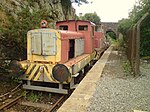St Ceidio's Church, Rhodogeidio

St Ceidio's Church, Rhodogeidio is a rural 19th-century church near Llannerch-y-medd, in Anglesey, north Wales. It was built using materials from the 14th-century church that previously stood on the site, which has been used for Christian worship since some time in the 7th century. The present building, which contains an east window dating from the 14th century and a 15th-century font, is no longer used for services, but has been looked after by local people. It is a Grade II listed building, a national designation given to "buildings of special interest, which warrant every effort being made to preserve them", in particular because it is "unusual in being built closely to the form and detail of its Medieval predecessor." Two 19th-century writers thought that the church was in a "dreary spot", but a 2006 guide to Anglesey churches describes it as being in a pleasant location with good views.
Excerpt from the Wikipedia article St Ceidio's Church, Rhodogeidio (License: CC BY-SA 3.0, Authors, Images).St Ceidio's Church, Rhodogeidio
Geographical coordinates (GPS) Address Nearby Places Show on map
Geographical coordinates (GPS)
| Latitude | Longitude |
|---|---|
| N 53.34226 ° | E -4.38757 ° |
Address
LL71 7BG , Llannerch-y-Medd
Wales, United Kingdom
Open on Google Maps






